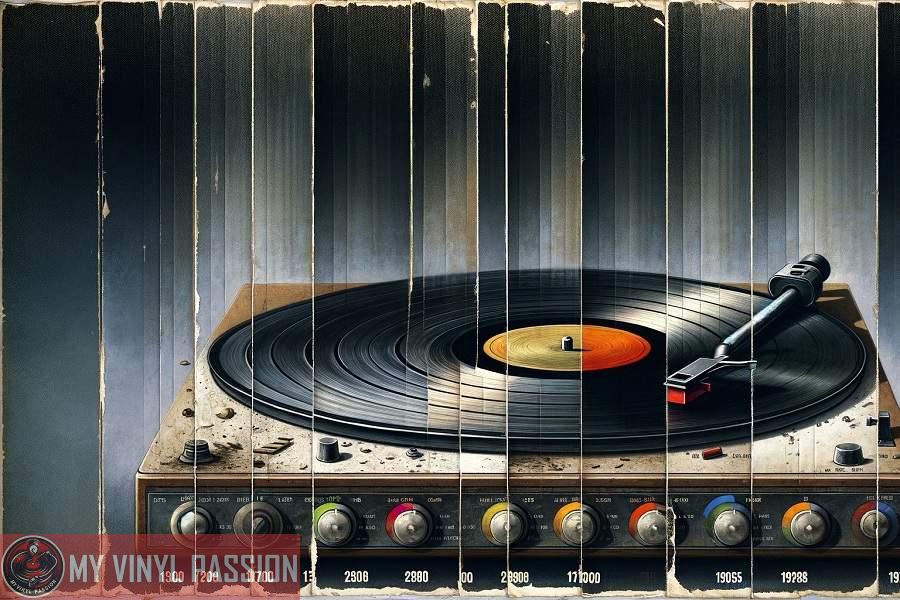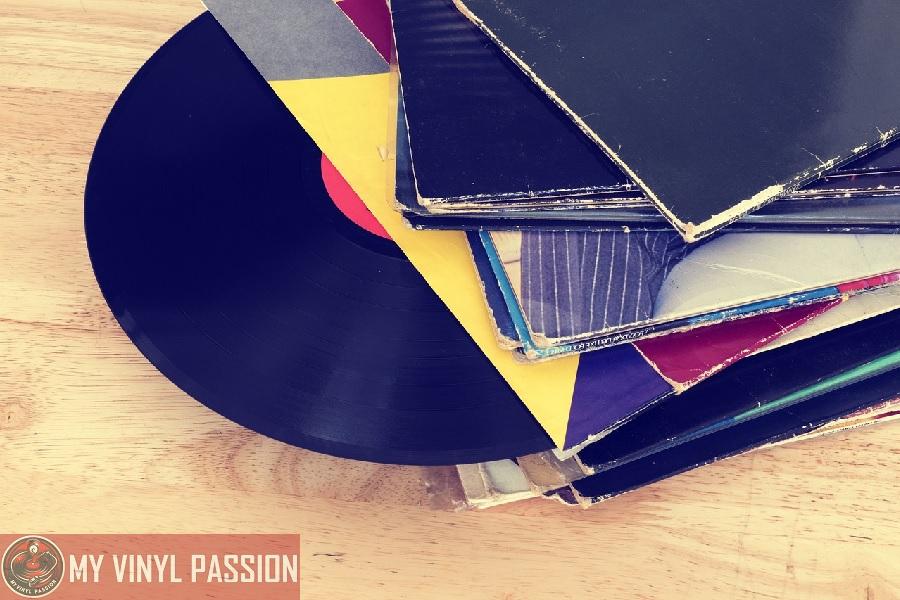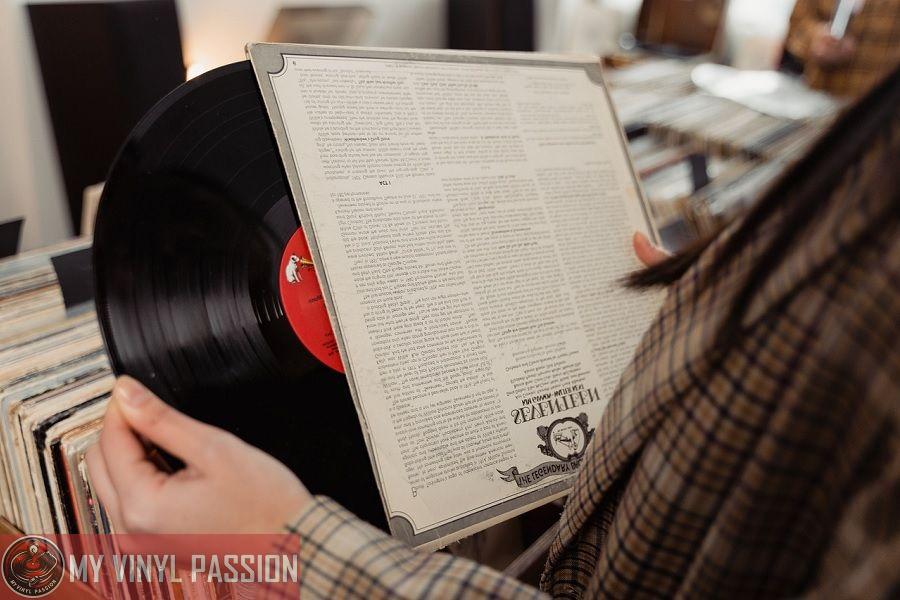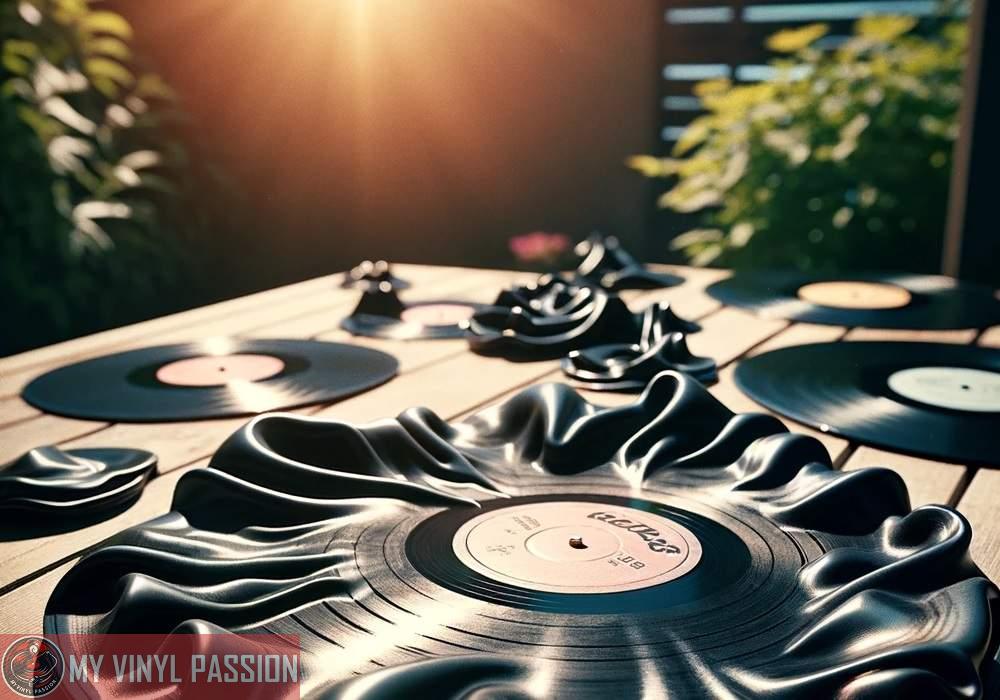Vinyl records have made a comeback in recent years, attracting both new and seasoned collectors.
Many wonder about the lifespan of a vinyl record, specifically how many times it can be played before the sound quality deteriorates or the record is damaged.
A vinyl record’s lifespan can vary greatly, depending on factors such as proper maintenance, storage, and usage.
In Summary
Proper maintenance and storage can extend a vinyl record’s lifespan.
Environmental factors can affect the number of times a record can be played.
High-quality record player and accessories are essential for preserving sound quality.
The physical and environmental impacts on a vinyl record can significantly influence how many times it can be played.
Record collectors should be diligent in preserving their vinyl collection, in order to prolong its life and maintain excellent sound quality. Additionally, investing in a high-quality record player and accessories can play a vital role in prolonging a record’s lifespan.
Vinyl Record Basics
Composition of Vinyl Records
Vinyl records are made primarily from polyvinyl chloride (PVC), a type of plastic material that is both durable and flexible. The PVC is mixed with various additives, such as stabilizers and pigments, to create the desired color and durability.
Vinyl records have grooves on their surface, which are designed to be read by a stylus on a turntable. These grooves represent the audio information stored on the record, and are what make it possible for you to listen to your favorite music.
The process of creating a vinyl record involves a few steps:
- Audio mastering: The raw audio files are processed and optimized for playback on vinyl.
- Cutting the master disc: The audio is etched into the grooves of a lacquer master disc, which is used to create stampers for mass production.
- Pressing: PVC pellets are melted and pressed into a disc using the stampers, transferring the audio from the master disc onto the vinyl record.
The Role of the Turntable and Stylus
To play a vinyl record, you’ll need a turntable. The turntable’s main job is to rotate the vinyl record at a consistent speed, typically 33 1/3 or 45 RPM (revolutions per minute), allowing the stylus to read the grooves.
The stylus, also known as a needle, is an essential part of the playback process. It’s usually made of diamond or another hard material, and is attached to the end of a tonearm. As the turntable spins the record, the stylus is lowered into the grooves.
The stylus moves through the grooves, following the audio information etched into the vinyl, and converts these vibrations into electrical signals. These signals are then amplified and sent to your speakers, allowing you to enjoy the music.
To get the best performance from a vinyl record, it’s essential to ensure your turntable, stylus, and vinyl are well-maintained.
By taking care of your equipment and records, and using products like LAST’s Record Preservative, you can achieve better sound quality and extend the lifespan of your vinyl records. Following proper handling and cleaning practices can also help ensure that your records can be played many times before showing signs of wear and tear.
Determining Record Lifespan
Factors Affecting Durability
The lifespan of a vinyl record is influenced by various factors that can impact its durability. First, the quality of the vinyl itself plays a crucial role in the longevity of a record. High-quality vinyl is less prone to wear and tear, ensuring a longer life for the record.
Next, the quality of your turntable and its components, such as the stylus or needle, can make a difference in the record’s durability. Ensure that you clean and maintain your turntable regularly, and replace worn components to minimize wear on your records.
Lastly, proper storage and handling are crucial in ensuring extended record life. Store your records vertically and away from direct sunlight and humidity to eliminate warping, and handle them by the edges to avoid contact with oils and dirt.
Estimated Number of Plays
Estimates for the number of times you can play a vinyl record vary depending on the factors mentioned above. For example, if you take excellent care of both your records and turntable, you could potentially play a record up to 1000 times before noticing any significant wear and tear.
On the other hand, if proper maintenance and handling are not followed, the number of plays a record can endure may decrease drastically. A more conservative estimate could be at least 100 times, but it is crucial you keep in mind the importance of proper care and handling.
Remember to find a balance between enjoying your vinyl collection and providing your records with adequate rest. This balance will help ensure that you can enjoy your vinyl records for as long as possible.
Physical and Environmental Impacts
Handling and Surface Damage
Proper handling of vinyl records is crucial to prevent wear and tear. Always hold records by their edges, as fingerprints can collect dirt and dust that may cause damage over time. When playing a vinyl record, friction between the stylus and the record grooves can also cause wear.
To minimize this damage, ensure your turntable’s tonearm, tracking force, and cartridge alignment are in optimal condition, and invest in a high-quality stylus.
Regular cleaning of your records can significantly reduce the potential damage caused by dust and dirt. Using an anti-static brush before each playback is a simple and effective method to maintain the condition of your vinyl.
Storage Conditions
Factors such as humidity, temperature, and exposure to sunlight can have a significant impact on the longevity of your vinyl records. To prevent warping and damage, store your records vertically and away from direct sunlight.
| Factors | Ideal Conditions |
|---|---|
| Humidity | A relative humidity of about 40-50% |
| Temperature | Around 65-70°F (18-21°C) |
Avoid stacking records horizontally as this may cause warping over time. Make sure that the shelves you use for storage are sturdy and capable of handling the weight of your vinyl collection.
A quality record sleeve will also offer extra protection for your records, preserving artwork and keeping dust and dirt away4.
By ensuring proper handling and storage conditions, you can maintain the quality and lifespan of your vinyl records, allowing you to enjoy your music collection for years to come.
Maintenance for Longevity
Cleaning Practices
To ensure a long life for your vinyl records, it’s crucial to establish a consistent cleaning routine. Regularly cleaning your records can help prevent the buildup of dust, dirt, and other particles that can cause pops, clicks, and unwanted noise.
Always use a gentle, lint-free cloth to wipe down your records, and consider investing in a vinyl record cleaning solution for optimal results.
For an organized cleaning process, follow these steps:
- Remove dust – Use a carbon fiber brush to remove surface dust before and after each play.
- Deep clean – Occasionally clean your records with a cleaning solution and microfiber cloth to remove ingrained dirt.
- Dry – After cleaning, allow your records to air dry completely before returning them to their sleeves.
Proper Usage and Handling
Proper handling and usage of your vinyl records are vital in maintaining their quality and longevity. Here are some guidelines for handling and using your records:
- Handling: Always hold your records by the edges or label, avoiding contact with the grooves to help prevent oil and dirt buildup.
- Sleeves: Use inner sleeves made of anti-static materials, like polyethylene, to minimize static electricity. Store your records vertically in record sleeves that can protect them from dust and debris.
- Proper storage: Maintain a consistent temperature and humidity level for storage, ideally between 65-70°F and 45-50% humidity. Keep your records away from direct sunlight or heat sources to prevent warping.
- Turntable and stylus: Invest in a quality turntable and stylus to minimize wear on your records. Regularly check and replace the stylus when needed, as a damaged one can cause further damage to your records.
By following these cleaning practices and proper handling guidelines, you can extend the life of your vinyl records, ensuring that you can enjoy them for many years to come.
Sound Quality Considerations
Effects of Wear on Audio
When it comes to vinyl records, preserving sound quality and the overall listening experience is essential. As you play your vinyl records, various factors can have an impact on the audio quality. Wear and tear on the grooves can result in undesirable audio artifacts like pops, clicks, surface noise, and distortion.
For a well-cared for record, it can be expected to be played more than 100 times with only minor audible sound degradation. However, poorly maintained or played records on improperly set-up equipment can experience significant deterioration in sound quality, sometimes even after a single play.
Here are some common effects of wear on audio quality:
- Pops and clicks: These sounds occur when the stylus encounters dust, dirt, or debris in the grooves or when the grooves have been damaged.
- Surface noise: This refers to the consistent background hiss or crackle that you might hear while your record is playing and is often a result of dust, dirt, or mold.
- Distortion: Over time, multiple plays can wear down the grooves, changing the shape and making it difficult for the stylus to track accurately, resulting in distorted audio.
Identifying Wear through Audio Cues
Being able to recognize the signs of wear on your records through audio cues can help you address issues and maintain the longevity of your vinyl collection. Here are some ways to identify wear:
- Listen carefully: Pay attention to any changes in the sound quality, particularly the presence of pops, clicks, or distortion that were not there before.
- Compare: If you have a digital copy of the same recording, compare it to the sound of your vinyl record to identify significant differences in audio quality.
- Note playback issues: When a vinyl record skips or jumps during playback, it could indicate groove wear or other damage on the surface of the record.
By being vigilant and identifying wear through audio cues, you can take steps to preserve the sound quality of your vinyl records and enjoy them for many years to come. Remember to handle your records with care and use the proper equipment to minimize wear and tear on your priceless collection.
Record Player and Accessory Care
Calibrating the Turntable Setup
Properly calibrating your turntable setup is essential to optimize sound quality and longevity of your vinyl records. Ensuring that your turntable is level and that the tracking force is properly adjusted can significantly reduce wear and tear on your records. To maintain a high-quality turntable setup, follow these steps:
- Level your turntable: Use a bubble level on the platter to check if your turntable is level. If needed, adjust the feet or place a shim underneath to achieve a level surface.
- Set the tracking force: The tracking force is the downward pressure applied by the stylus on the record. Refer to the manufacturer’s guidelines for the appropriate tracking force range for your cartridge, and use a stylus force gauge to measure it accurately.
- Adjust the anti-skate: Anti-skate is a counteracting force that prevents the stylus from being pulled towards the center of the record. Set the anti-skate to the same value as your tracking force.
By calibrating your turntable setup, you can enjoy a better sound quality and preserve the life of your vinyl records.
Importance of Stylus and Cartridge Condition
The stylus, also known as the needle, and the cartridge are critical components of your equipment. They determine the quality of the sound produced and are the primary point of contact between your records and the turntable.
- Regularly inspect your stylus: Check for signs of wear or damage on the stylus. If you notice it has become worn, damaged, or caked with dust, it should be replaced. A worn stylus can cause degradation of the record’s sound or even damage your records.
- Clean your stylus: Use a stylus brush and stylus cleaning solution to gently remove dust and debris. This helps maintain optimal sound quality and prolongs the life of your stylus and records.
- Upgrade your cartridge: Consider upgrading to a high-quality cartridge if you’re using an entry-level component. A better cartridge can significantly enhance the sound quality and protect your records from unnecessary wear.
Paying attention to the condition of your stylus and cartridge will not only improve your listening experience but also extend the lifespan of your vinyl collection.
Comparisons with Digital Formats
Vinyl vs. Digital Music Longevity
When it comes to longevity, vinyl records and digital music formats have their own advantages and disadvantages. With proper care, a vinyl record can be played more than 100 times without significant sound degradation.
On the other hand, digital music files can last indefinitely as long as the storage medium remains intact and you have a backup copy.
However, vinyl records are susceptible to physical wear, dust, and scratches. By maintaining your record collection, you can prolong the life of your vinyls and enjoy their unique sound qualities. Digital music formats, such as MP3 and FLAC, are not subject to the same physical wear but can suffer from eventual data corruption or storage failures.
Analog Sound and Collectibility
Vinyl records offer an analog sound that many music lovers appreciate for its warmth and natural sound quality. The process of creating a vinyl record involves cutting grooves into a master disc, which captures the audio in an analog format. This results in a listening experience that some feel is more authentic and closer to the original performance.
In contrast, digital recording involves converting the analog sound into digital bits that can be stored and reproduced electronically. While digital music formats are convenient and store music with higher sound quality and accuracy, there is still a debate among audiophiles about the superiority of analog sound.
Another aspect to consider is collectibility. With the resurgence of vinyl records, many people enjoy building their vinyl collection. This includes hunting for rare or special edition releases, securing colored vinyls, or collecting album artwork.
A record collection is a tangible representation of a person’s taste in music, and its physical presence can evoke an emotional connection.
Digital music, while easily accessible, lacks this tangible element. Your digital library can store thousands of songs, but the experience of scrolling through screens of metadata is not as engaging as browsing a carefully curated vinyl collection.
To summarize:
- Vinyl records can be played over 100 times with proper care
- Digital music files last indefinitely if properly stored and backed up
- Vinyl offers a warmer, more natural analog sound compared to digital formats
- Collectibility and emotional connection are factors unique to vinyl collections
Ultimately, the choice between vinyl records and digital music formats comes down to personal preference. Explore both options and see which experience best suits your tastes and interests.
Frequently Asked Questions
What factors determine a vinyl record’s lifespan when played regularly?
There are several factors that determine the lifespan of a vinyl record when played regularly, including storage conditions, cleanliness, handling, and proper use of turntable equipment. Store your records vertically and away from direct sunlight or sources of heat and moisture. Handle them carefully with clean hands, touching only the edges to avoid contamination and damage to the grooves. Additionally, regularly clean both the records and your turntable, ensuring proper alignment of the stylus to keep the sound quality intact and minimize wear.
What is the average number of times a vinyl record can be played before it starts to degrade?
The average number of times a vinyl record can be played before noticeable wear occurs largely depends on its maintenance and handling. Some specialist record preservation products, such as LAST, claim that a new, clean, and properly stored vinyl record can be played a minimum of 200 times without discernible wear.
How does proper maintenance extend the playability of vinyl records?
Proper maintenance plays a crucial role in extending the playability of vinyl records. Regular cleaning to remove dust, dirt, and fingerprints can prevent the buildup of contaminants that can damage grooves and affect sound quality. Proper storage and handling also reduce the risk of warping, scratches, or other physical damage that may hinder playability.
Can the type of turntable used affect the longevity of vinyl records?
Yes, the type of turntable used in playing vinyl records can indeed affect their longevity. High-quality turntables with proper calibration can minimize wear on records by ensuring optimal alignment of the stylus, weight distribution, and tracking. Cheaper turntables with poor quality components may cause excessive wear or damage to your records over time.
Is there a difference in durability between standard and laser turntables for playing records?
Laser turntables offer a unique advantage over standard turntables in terms of durability. A laser turntable uses a light beam to read the grooves of the record, eliminating physical contact and minimizing the wear and tear on the vinyl. However, laser turntables are rare and often expensive, which may not be practical for casual vinyl enthusiasts.
At what point should a record stylus be replaced to prevent vinyl wear?
To maintain optimal playability and prevent vinyl wear, it’s essential to replace a record stylus when it begins to show signs of wear or damage. Generally, a stylus should be replaced after approximately 1,000 hours of playtime. Signs to look for include skipping, distorted sound, or excessive surface noise. Regular inspection and cleaning can help extend the life of your stylus and protect your vinyl collection.





